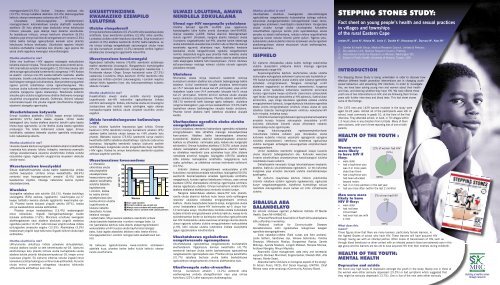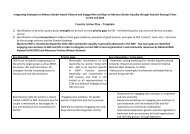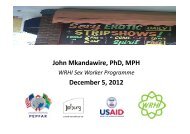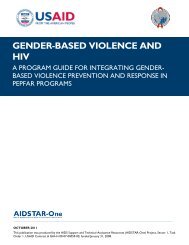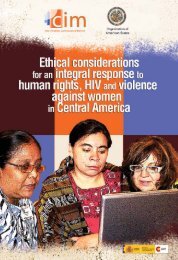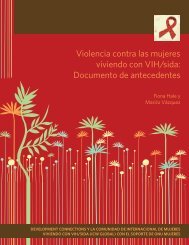Create successful ePaper yourself
Turn your PDF publications into a flip-book with our unique Google optimized e-Paper software.
nasengqondweni(15.5%) ibonise iimpawu ezichaza oko<br />
(13.7%). Omnye kubafana abahlanu (10.4%) ebenxunguphele<br />
kakhulu okanye eneempawu ezibonisa oko (9.4%).<br />
Ukuqatsela kokunxunguphala emphefumlweni<br />
nasengqondweni kubonakaliswe kukuba abathathi nxaxheba<br />
abahlanu (5) kolu phando baye bazibulala emva kokubuzwa<br />
imibuzo yokuqala, yaye abanye baye bazama ukuzibulala.<br />
Xa besibabuza imibuzo, omnye kwishumi elinambini (8.2%)<br />
labafana yaye emnye kwiintombi ezimgamashumi amane (2.6%)<br />
bathe bakhe bacinga ngokuzibulala kwiiveki ezine phambi<br />
kokubuzwa imibuzo okokuqala. Ukuzibulala ngoyena mbulali<br />
kulutsha oluthabatha inxaxheba kolu phando, yaye yeyona nto<br />
yenza ukufa ngaphezu kweengozi nobundlobongela.<br />
Ithetha ukuthini le nto?<br />
Sikhe sive kusithiwa i-HIV ngoyena nobangela wokuzibulala<br />
kolutsha olukule minyaka. Thina sifumanise ukuba iintombi ezine-<br />
HIV zinamathuba amabini nesiqingatha (2.5% times) okuba athi<br />
akhe acinga ngokuzibulala kuneentombi azingenayo i-HIV. Kodwa<br />
ke akakho namnye one-HIV kwaba bathathi-nxaxheba abathe<br />
bazibulala. Izizathu zokuzibulala bezingafani, kodwa uninzi lwazo<br />
bezihlangene neengxaki zokuthandana. Abanye bebenxunguphele<br />
ngenxa yezinto ezibehleleyo ezinje ngokudlwengulwa. Oku<br />
kuchaza ukuba kufuneka kubekwe phambili impilo-ngengqondo<br />
yolutsha njengeyona ngxaki ebalaseleyo. Bekufanele kubekho<br />
amaziko apho ulutsha lungafumana uthetha-thethwano nonyango<br />
ukuphelisa unxunguphalo abanalo. Ootitshala, iitshomi nabazali<br />
kufumenaka bayazi into yokuba iingxaki zokuthandana zingajiya<br />
ebantwini abangaka ngeminyaka.<br />
Ukuxhatshazwa kotywala<br />
Emnye kubafana abathathu (62%) kwaye emnye kisihlanu<br />
seentombi (21%) bakhe basela utywala. Uninzi lwabo<br />
bebengaseli qho, kodwa abafana abaninzi bekuthi apho basela<br />
khona baye ngamandla. Le nto ithetha ukuba basela ngendlela<br />
enobungozi. Yile ndlela iindlamanzi ezisela ngayo. Emnye<br />
kwisithathu sabafana bebesela utywala ngendlela enobungozi<br />
kubo nakwabanye abantu.<br />
Ithetha ukuthini le nto?<br />
Ukusela utywala kakhulu kuyingxaki kubafana abaninzi abathatha<br />
inxaxheba kolu phando. Izikolo, iintsapho, neenkonzo zezempilo<br />
zidinga ukusebenzisana ukuzama ukutshintsha iindlela ulutsha<br />
olosuleleka ngayo, ingakumbi ukugqininisa ekuyekeni ukokuba<br />
ziindla-manzi.<br />
Ukusetyenziswa kweziyobisi<br />
Sibuze abathathinxaxheba ukuba bakhe basebenzisa uhlobo<br />
oluthile lweziyobisi. Umfana omnye kwabathathu (38.4%)<br />
nentombi enye kwangamashumi amabini (6.4%) bakhe<br />
basebenzisa iziyobisi. Intsangu nebenzene zezona ziyobisi<br />
ebezisetyenziswa.<br />
Ulwaluko<br />
Isiqingatha sabafana sele solukile (53.1%). Kwaba bolukileyo<br />
sisiqingatha (53%) esoluka, ngaphambi kweminyaka eyi-17<br />
kwaye bathathu kwisine aboluke ngaphambi kweminyaka eyi-<br />
18. Phantse bonke boluswe yingcibi yesintu (87%), kodwa<br />
emnye kwabasibhozo woluke esibhedlele.<br />
Phantse omnye kwabasibhozo (13.4%) wabanengxaki<br />
emva kokwaluka. Iingxaki bezingaxhaphakanga kwabo<br />
bolukele esibhedlele (7.6%). Mncinane umohluko kwiingxaki<br />
abahlangabezene nazo abafana aboluswe yingcibi esebenza<br />
ngendlela yesintu (14.3%) nabo boluswe yingcibi exhasa indlela<br />
ezilungiselwe amaxesha angoku (12.5%). Abambalwa (3.3%)<br />
kwaboluswe yingcibi baye bafumana iingxaki ezifune ukuba baye<br />
esibhedlela.<br />
Ithetha ukuthini le nto?<br />
URhulumente ukhuthaza indlela yolwaluko ekhuselekileyo,<br />
nokuba abafana boluke xa sele beneminyaka eyi-18. Iziphumo<br />
esizifumeneyo kolu phando zichaza ukuba kuxhaphakile ukuba<br />
abafana boluke phambi kokubaneminyaka eyi-18, kwaye uninzi<br />
lusoluswa yingcibi. Ezi ziphumo zibonisa nokuba iingxaki emva<br />
kokwaluka azixhaphakanga xa umfana oluke esibhedlele. Kucacile<br />
ukuba mninzi umsebenzi odingekayo ukucacisa isikhundla<br />
uRhulumente asithathayo kulo mba.<br />
UKUSETYENZISWA<br />
KWAMAZIKO EZEMPILO<br />
LULUTSHA<br />
Ulutsha olungabazali<br />
Omnye kwisixhenxe sabafana (16.2%) sithi sikhe saxelelwa ukuba<br />
simithisile. Enye kwiintombi ezintlanu (21.8%) zikhe zamitha.<br />
Lumbalwa ulutsha oluthe lwalufuna ukumitha. Enye kumashumi<br />
amabini (4.3%) abafana neentombi (3.6%) bathe babefuna. Le<br />
nto ichaza isidingo esingekafezeki sezicwangcisi ukuba mnye<br />
nje qha kumashumi amabini (4.2%) eentombi emithe ingafuni<br />
ebisebenzisa izicwangcisi ngaphambi kokumitha.<br />
Ukusetyenziswa kwezicwangcisi<br />
Ngokubanzi bathathu kwisine (76.8%) seentombi ezilalanayo<br />
ezakhe zasebenzisa izicwangcisi. Bangaphezulu kwesiqingatha<br />
(55.1%) seentombi ebesebenzisa izicwangcisi besebenzisa i-<br />
Nuristerate okanye i-Depo. Emnye kwiintombi ezine (27.2%)<br />
usebenzise ii-condoms. Mnye kwishumi (9.9%) leentombi othe<br />
usebenzisa iintlobo ezimbini zokucwangcisa, i-condom neepilisi<br />
okanye isitofu ngaxesha linye. oku kokunqwenelekayo kubantu<br />
abakule minyaka.<br />
Ithetha ukuthini le nto?<br />
Kuyakhuthaza ukwazi ukuba ulutsha oluninzi kangaka<br />
luyazikhusela kwi-HIV nokumitha ngokudibanisa iintlobo<br />
ezimbini zezicwangcisi. Kodwa, sifumanise ukuba ezi zicwangcisi<br />
zisetyenziswa sele kudlule ixesha ezidingeka ngalo okanye<br />
manqapha-nqapha kakhulu ukuze zinqande ukumitha umntu<br />
engafuni.<br />
Uhlolo lwentsholongwane kaGawulayo<br />
i-HIV.<br />
Uninzi lolutsha lwalukhe lwavavanya igazi luhlola. Omnye<br />
kwishumi (10%) leentombi nomnye kumashumi amabini (4%)<br />
abafana bakhe bahlola ukuba banayo na i-HIV phambi kolu<br />
phando. Bathathu kwisine (73.6%) seentombi kunye nesibini<br />
kwisithathu (68%) sabafana abazithathayo iziphumo zabo emva<br />
kovavanyo. Isiqingatha seentombi ezaziyo iziphumo sasikhe<br />
samithakwaye kungenzeka ukuba kungeluthuba baye bazihlola<br />
i-HIV ngalo. Kodwa ke omnye kwisixhenxe seentombi ezazikhe<br />
zahlowa wayekhe wamitha.<br />
Ukusetyenziswa kweecondoms<br />
Lo mfanekiso<br />
ukhombisa ukuba<br />
sekuxhaphakile<br />
ukusetyenziswa<br />
kweecondoms apho<br />
ababini kwisithathu<br />
solutsha babekhe<br />
bayisebenzisa<br />
i-condom, kodwa<br />
ke ixesha elininzi<br />
ayisetyenziswa qho.<br />
Ixesha elininzi ulutsha<br />
luyazikhusela xa<br />
lulalana nabantu<br />
bexeshana, kunaxa<br />
belalana noongqo<br />
/ oofasti babo. Mnye kwisine sabafana neentombi ochaze<br />
ukuba basoloko besebenzisa i-condom noongqo babo. Le<br />
nto iyaxhalabisa kakhulu kuba abantu abasemngciphekweni<br />
wokusuleleka yi-HIV kucaca ukuba bayifumana koongqo<br />
babo, kuba ingabo abasoloko belalana nabo ixesha elininzi.<br />
Ukungayisebenzisi i-condom noongqo babo akubakhuseli kwi-<br />
HIV.<br />
Xa bebuzwa ngokufumaneka kwee-condoms ezindaweni<br />
abahlala kuzo, phantse bonke bathe kulula kakhulu okanye<br />
kulula ukuzifumana.<br />
ULWAZI LOLUTSHA, AMAVA<br />
NENDLELA ZOKULALANA<br />
Ulwazi nge-HIV nangempilo yokulalana<br />
Ulutsha belusazi nge-HIV ne-AIDS yaye ngaphezulu<br />
kwesiqingatha luthe kukho umntu olumaziyo one-HIV/AIDS.<br />
okanye osweleke yi-AIDS. Kodwa abaninzi bebengenalwazi<br />
olululo nge-HIV. Umzekelo, nangona abantu bebesazi ukuba<br />
ii-condoms zingabakhusela kwi-HIV, phantse bonke bebecinga<br />
ukuba kufanelekile ukusebenzisa icondom ude umthembe okanye<br />
waneliseke ngumntu othandana naye. Abathathu kwabane<br />
bavakalise ukuba bangazikhusela ngokuba bangathandani<br />
nomntu obesandula kugula yaye phantse ihafu ivakalise ukuba<br />
bangazikhusela kwi-HIV ngokhetha abantu abantu abathandana<br />
nabo abajongeka bebahle futhi besempilweni. Zininzi izikhewu<br />
ezifunyanisiweyo malunga nolwazi ulutsha olunalo ngempilo<br />
yokulalana nenzala.<br />
Ukulalana<br />
Sifumanise ukuba imnye kwishumi leentombi nomnye<br />
kumashumi amabini abafana kolu phando bebengazange bakhe<br />
balalane. Uninzi lweentombi baqale ukulalana beneminyaka<br />
eyi-15.7 (ukuqala kwi-8 ukuya kwi-22 yeminyaka), yaye uninzi<br />
lwabafana luqale lune-14.4 yeminyaka (ukuqala kwi-5 ukuya<br />
kwi-21 yeminyaka). Iintombi ezininzi zachaza ukuba ukuqala<br />
kwazo ukulalana zazinyanzelisiwe, Phantse ababini kwisithathu<br />
(58.1%) seentombi bathi bacenga ngoku babeqala ukulalana<br />
nangona babengafuni, yaye omnye kwabasibhozo (13.0%) bathi<br />
baqhathwa okanye badlwengulwa ukuqala kwabo ukulalana.<br />
Phantse bonke abafana bathi babefuna ukulalana ukuqala<br />
kwabo.<br />
Ukuthandana ngendlela ebeka ulutsha<br />
emngciphekweni<br />
Uninzi lwabafana neentombi bathandana ngeendlela ezibabeka<br />
emngciphekweni. Sele sithethile malunga nokusetyenziswa<br />
kwe-condom. Abafana bathe banamaqabane amaninzi<br />
kuneentombi. Abafana abaninzi bebenamaqabane amaninzi<br />
kakhulu xa uthelekisa neminyaka yabo, kodwa oku kungenjalo<br />
ezintombini. Omnye kubafana abahlanu (19.2%) uchaze ukuba<br />
ulalane namaqabane alishumi nangaphezulu ebomini bakhe,<br />
xa uthelekisa neentombi zona ezimbalwa kuzo zithe zilalane<br />
namadoda amaninzi kangako. Isiqingatha (49.5%) sabafana<br />
sithe silalane namaqabane amathathu nangaphezulu kulo<br />
nyaka uphelileyo, xa uthelekisa nomnye kwiintombi ezilishumi<br />
(10.5%).<br />
Iintombi zibekwa emngciphekweni wokusuleleka yi-HIV<br />
kukulalana namadoda amadala nafundileyo. Isiqingatha (50.5%)<br />
seentombi besinamaqabane amadala ngeminyaka emithathu<br />
nangaphezulu kunabo ngeliza bebebuzwa imibuzo, yaye omnye<br />
kwabane (26%) ebeneqabane elimshiya ngeminyaka emihlanu<br />
okanye ngaphezulu ubudala. Omnye kumashumi amabini (6%)<br />
abafana ebelalana ebethandana nentombi endala kunaye.<br />
Nangona bebambalwa abafana abane-HIV kolu phando,<br />
icacile ukuba abaninzi kakhulu kubo benza izinto ezihlangene<br />
nesondo/ ukulalana ezibabeka emngciphekweni omkhulu<br />
kakhulu. Ukuba bayaqhubeka besenza kanje, kungenzeka ukuba<br />
uninzi lwababafana lubene-HIV kwiminyaka eyi-5 ukuya kwi-<br />
10 leminyaka ezayo. Ukuthandana nendoda endala kubonakele<br />
kubeka iintombi emngciphekweni omkhulu kakhulu, kwaye le nto<br />
ayichatshazelwa konke xa kwinkqubo ezifundisa ngokuzikhusela<br />
kwi-HIV. Kubalulekile ukuba kwenziwe amalinge okunika abantu<br />
ulwazi ngezinto ezibeka ulutsha emngciphekweni wokusuleleka<br />
yi-HIV, futhi nokuba ulutsha lutshintshe iindlela oluziphethe<br />
ngayo ngezokulalana nokuthandana.<br />
Ukuxhatshazwa ngokubethwa<br />
nangokwesondo ngamaqabane<br />
Ukuxhatshazwa ngokubethwa nangokwesondo kuxhaphakile<br />
ekuthandaneni. Ngaphezulu komnye kwisithathu (41.7%)<br />
seentombi bachaze ukuba bakhe baxhatshazwa ngokubethwa<br />
nangokwesondo ngamaqabane awo. Phantse emnye kwisithathu<br />
(31.7%) sabafana bachaze ukuba bakhe baxhatshazwa<br />
ngokubethwa nangokwesondo ziintombi abathandana nazo.<br />
Ukudlwengula noku-streamlina<br />
Omnye kumashumi amabini i (4.2%) eentombi ukhe<br />
wadlwengulwa yindoda ebengathandani nayo yaye omnye<br />
kwisihlanu (22%) ukhe wazanywa ukudlwengulwa.<br />
Ithetha ukuthini le nto?<br />
Ukuxhaphaka okukhulu kweziganeko zobundlobongela<br />
ngokubethwa nangokwesondo kubonakalisa isidingo esikhulu<br />
sokucacisa ukunganyamezeleki nokungamkeleki kwezi zenzo,<br />
ngokuyilwa ezikolweni, kwiintsapho nasekuhlaleni. Kungenzeka<br />
ukuba ulutsha lucinge ukuba ukuxhaphaka kokubetha<br />
nokuzithathela ngolunya isondo yinto eyamkelekileyo ukuba<br />
yenzeke xa abantu bethandana, nokuba umfana angazithathela<br />
ngolunya isondo nokuba intombi yakhe ayifuni. Ngenxa yoku,<br />
kubalulekile ukuba kubekho iinkonzo ezizakwazi ukuba ngoobani<br />
abadlwenguliweyo okanye ekuzanywe ukuba badlwengulwe,<br />
kwanobubaxhasa.<br />
ISIPHELO<br />
Ezi ziphumo zibonakalisa ukuba kukho isidingo sokufundisa<br />
ulutsha olusezilalini e-Mpuma Koloni malunga ngempilo<br />
ngokwesondo nange-HIV.<br />
Kuyanxunguphalisa kakhulu ukufumanisa ukuba ulutsha<br />
olukunyaka wokugqibela esikolweni luphuma sele losulelekile yi-<br />
HIV kwaye kuxhaphakile ukuba ulutsha lube lulalana ngeendlela<br />
ezibabeka emngciphekweni. Nangona namazinga e-HIV<br />
ebafaneni engaphantsi xa ethelekwa naweentombi, kungenxa<br />
yokuba uninzi lwabafana luthandana neentombi ezincinane<br />
kunabo ngeminyaka kwaye ezintombi zisencinane azikosuleleki<br />
ngeli thuba. Amazinga okosuleleka yi-HIV aphezulu, ikakhulukazi<br />
ezintombini, yaye izinga lokulalana ngendlela ezibeka ulutsha<br />
emngciphekweni liphezulu. Izinga eliphezulu lokulalana ngendlela<br />
ebeka umntu emngciphekweni omkhulu ichaza ukuba eli qela<br />
labafana lizakube lisemngciphekweni omkhulu wokubane-HIV<br />
kule minyaka. embalwa ezayo.<br />
Iintombi zona zisemngciphekweni ngenxa yokubanamaqabane<br />
amadala kunazo Iinzame zokunqanda ukosuleleka yi-HIV<br />
kufuneka zikhuthaze iintombi ukuba zithandane nabantu<br />
abasondeleyo kubo ngeminyaka.<br />
Izinga lokunxunguphala ngokwasemphefumlweni<br />
nokuzibulala lisibeka exhaleni yaye libonakalisa ukuba<br />
kufuneka kubekho iinkonzo yezempilo ngengqondo ejongana<br />
nolutsha olusezikolweni, neenkonzo ezisebenza ngokuxhasa<br />
ulutsha kwingxaki ezibangela ukuxunguphala emphefumlweni<br />
nasengqondweni.<br />
Uninzi lwabafana neentombi lungabazali kwaye kucacile<br />
ukuba abaninzi babengekakufuni oko. Kufuneka kwenziwe<br />
iinzame zokukhuthaza ukusetyenziswa kwezicwangcisi lulutsha<br />
nokufikelela kwazo ezilalini.<br />
Sikhathazekile kananjalo lizinga lokuxhatshazwa kwabantu<br />
abatsha, ikakhulu ukuxhatshazwa ngokwesini. Le nto kufuneka<br />
ilungisiwe yaye amaziko okunceda ulutsha oluxhatshaziweyo<br />
ayadingeka.<br />
Ezi ziphumo ziyayixhasa kakhulu imbono yokufundisa<br />
iintombi nabafana ezilalini ngempilo ngokwesondo, ngokuzala<br />
kunye nangokwasengqondo, kwakhona kunesidingo sokuza<br />
neendlela zokungenelela ukuza kuliwe ezi zinto zichaphazela<br />
ulutsha.<br />
SIBALULA ABA<br />
BALANDELAYO<br />
Esi sifundo sixhaswe ngemali yi-National Institute Of Mental<br />
Health, Grant MH 64882-01.<br />
I-Planned Parenthood Association of South Africa ebeliqabane<br />
lethu elifundisa ii-workshop.<br />
I-National Institute for Communicable Diseases<br />
belusebenzisana nathi ngokutsalwa nokugcinwa kwegazi<br />
ngendlela esemgangathweni.<br />
Iinesi nabadlani-ndlebe (Field nurses and field workers):<br />
Leslie Setheni, Sandisiwe Joyi, Veliswa Gobinduku, Yandisa<br />
Skweyiya, Mthokozisi Madiya, Bongwekazi Rapiya, Sanele<br />
Mdlungu, Ayanda Mxekezo, Lungelo Mdekazi, Nocawe Mxinwa,<br />
Andiswa Njengele, Mvuyo Mayisela.<br />
Abancedisi (Data management, data entry and secretarial<br />
support): Bomkazi Mnombeli, Engela Gerber, Dikeledi Moti, Alta<br />
Hansen, Martie Swart.<br />
Abacebisi bethu (Advisors on biological aspects of the <strong>study</strong>):<br />
Dr Adrian Puren, NICD; Prof Daniel Kayongo, UNITRA. Chief<br />
Mtirara nawo onke amalungu eCommunity Advisory Board.<br />
STEPPING STONES STUDY:<br />
Fact sheet on young people’s health and sexual practices<br />
in villages and townships<br />
of the rural Eastern Cape<br />
Jewkes R 1 , Jama N 1 , Nduna M 1 , Levin J 2 , Dunkle K 1 , Khuzwayo N 1 , Duvvury N 3 , Koss M 4<br />
1. Gender & Health Group, Medical Research Council, Umtata & Pretoria;<br />
2. Bio-statistics Unit, Medical Research Council, Pretoria;<br />
3. International Centre for Research on Women, Washington DC;<br />
4. School of Public Health University of Arizona, Tucson, USA<br />
INTRODUCTION<br />
The Stepping Stones Study is being undertaken in order to discover how<br />
effective different health promotion interventions are in changing youth<br />
sexual behaviour, and preventing HIV infections. In order to investigate<br />
this, we have been asking young men and women about their health<br />
and lives, and learning whether they have HIV. We have offered these<br />
youth one of two interventions on HIV, and are following them for two<br />
years with further interviews and blood tests. This fact sheet shares<br />
some of the findings.<br />
The 1375 men and 1429 women involved in the <strong>study</strong> were<br />
aged 16-23 years. Almost all of the participants were still in<br />
school, most commonly in grade 10, at the time of the first<br />
interview. They attended school, or lived, in 70 villages within<br />
1.5 hours drive in any direction from Umtata. Many of them<br />
were orphans, with one in three reporting loss of one or both<br />
parents.<br />
HEALTH OF THE YOUTH :<br />
HIV<br />
Women were 12% of women had HIV<br />
more likely<br />
to have HIV if<br />
they:<br />
• were older<br />
• had a boyfriend who<br />
was 3 or more years<br />
older than them<br />
• had a boyfriend who<br />
had been educated<br />
beyond matric<br />
• had 3 or more partners in the last year<br />
• had sex more often (within the last 2 months)<br />
Men were more<br />
likely to have<br />
HIV if they:<br />
• were older<br />
• had not been<br />
circumcised<br />
• had ever had sex with<br />
a man<br />
2% of men had HIV<br />
What does this<br />
mean?<br />
These figures show that there are many learners, particularly female learners, in<br />
the highest Grades of school who have HIV. These learners will have acquired HIV<br />
through having sex with an infected partner. Other routes of transmission of HIV, such as<br />
through blood transfusion or other contact with an infected person’s blood are extremely rare in this<br />
age group and the learners are too old to have acquired HIV from their mothers during childbirth.<br />
HEALTH OF THE YOUTH:<br />
MENTAL HEALTH<br />
Depression and suicide<br />
We found very high levels of depression amongst the youth in the <strong>study</strong>. Nearly one in three of<br />
the women were either seriously depressed (15.5%) or had symptoms which suggested that<br />
they might be seriously depressed (13.7%). One in five of the men were either seriously<br />
Building a healthy nation<br />
through research
depressed (10.4%), or had symptoms suggesting that they might<br />
be seriously depressed (9.4%).<br />
The seriousness of this situation was shown by the fact that<br />
4 of the <strong>study</strong> participants committed suicide in the year after<br />
their interview and some others attempted suicide. When we<br />
interviewed them one in 12 of the men (8.2%) and 2.6% of<br />
women said they had thought of suicide in the 4 weeks prior to<br />
the interview. Suicide is the leading cause of death amongst our<br />
participants and causes more deaths than accidents or violence.<br />
What does this mean?<br />
We often hear that HIV is the cause of suicides in this age group.<br />
We found that women with HIV were 2.5 times more likely to<br />
say they had thought of suicide than HIV- women. However<br />
none of the <strong>study</strong> participants who committed suicide had HIV.<br />
There were different reasons, but most common was having<br />
boyfriend or girlfriend problems. Others were depressed because<br />
of experiences of trauma, including rape. This suggests that the<br />
mental health of teenagers needs to be prioritised as a serious<br />
problem. There should be accessible services for counsel and<br />
treat depressed youth. Teachers, peers and parents need to be<br />
aware that boyfriend/girlfriend problems can be very serious in<br />
this age group.<br />
Alcohol abuse<br />
Two thirds of men (62.7%) and one in five women (21%) had at<br />
some time drunk alcohol. Most did not drink very often, but most<br />
men drank quite a lot when they did so. This meant that they still<br />
drank dangerously. This is called binge drinking. One in three of<br />
the men drank alcohol in a way which was potentially dangerous<br />
to themselves or others.<br />
What does this mean?<br />
Risky alcohol drinking is a problem for many of the young men<br />
in the <strong>study</strong>. Schools, families and health services need to work<br />
together to try to change drinking practices, with a particular<br />
focus on reducing binge drinking.<br />
Drug use<br />
We only asked whether participants had ever used certain types<br />
of drugs. One in three of the men (38.4%) and one in twenty of<br />
the women (6.4%) had used drugs. Dagga and benzene were the<br />
main drugs used.<br />
Circumcision<br />
Half the men (53.1%) in the <strong>study</strong> had been circumcised. Of<br />
these half (53%) had been circumcised before the age of 17<br />
and three quarters (70%) before the age of 18. Almost all had<br />
been to a traditional surgeon (87.4%), but one in eight had been<br />
circumcised at the hospital.<br />
Roughly one in eight (13.4%) had experienced a problem after<br />
circumcision. This was less common amongst those circumcised<br />
in hospital (7.6%). There was little difference in its commonness<br />
amongst those who said they were circumcised by a traditional<br />
surgeon using traditional methods (14.3%) or modern methods<br />
(12.5%). 3.3% of those circumcised by a traditional surgeon<br />
experienced problems which required them to attend hospital<br />
What does this mean?<br />
The Government is promoting safer circumcision, including<br />
circumcision after the age of 18. Our findings suggest that it is<br />
most common for boys to be circumcised before they are 18,<br />
and most are circumcised by a tradition surgeon. They also show<br />
that complications are much less common if<br />
circumcision to be undertaken in hospital. Clearly<br />
a lot more work is needed to communicate the<br />
Government’s position on this issue.<br />
YOUTH UPTAKE OF<br />
HEALTH SERVICES<br />
Youth as parents<br />
One in seven of the men (16.2%) said they had<br />
been told they had made a woman pregnant.<br />
One in five of the women had had a pregnancy<br />
(21.8%). Very few of the youth said they wanted<br />
the pregnancy. One in twenty of the men (4.3%)<br />
and women (3.6%) said they had wanted it. This suggests a very<br />
substantial unmet need for contraception. Only one in twenty of<br />
the women (4.2%) who had had an unwanted pregnancy had<br />
used contraception before they became pregnant.<br />
Contraceptive use<br />
Overall three quarters (76.8%) of women who had ever had sex<br />
had used contraceptives. More than half (55.1%) of the women<br />
using contraception were using Nuristerate/Depo. Condoms were<br />
used by a quarter (27.2%). One in ten (9.9%) reported duel<br />
method use – condoms and the pill/injection – this is a particularly<br />
desirable approach in the age group.<br />
What does this mean?<br />
It is encouraging this many young people are protecting themselves<br />
against HIV and pregnancy by using dual methods. However,<br />
our findings show that contraceptives are either being used too<br />
late or too intermittently to avoid unwanted pregnancy. There<br />
is considerable unmet need for contraception amongst young<br />
men and women and it is important that efforts are continued to<br />
improve access and use by young people.<br />
HIV testing<br />
Many of the young people had previously had a HIV test. One<br />
in ten of the women (10%) and one in twenty of the men (4%)<br />
had tested for HIV before the <strong>study</strong>. Three quarters of women<br />
(73.6%) and two thirds of men (68%) had collected their results<br />
after the test. Half of the women who learnt their status had<br />
been pregnant and this may have been when they were tested.<br />
However only 16% of women who had been pregnant had been<br />
tested for HIV.<br />
Condom use<br />
This shows that condom use is common now with two in three<br />
youth having ever used a condom, but much condom use is<br />
irregular. Casual sex is more commonly protected than sex with<br />
a main partner. Only one in four women and men always use a<br />
condom with a main partner. This is a particular worry as people<br />
who catch HIV are most likely to catch it from their main partner,<br />
as they usually have sex more frequently with this person. This<br />
may not be sufficient to protect them from HIV. Almost all young<br />
people said that it was ‘very easy or easy’ to get a condom in<br />
their area.<br />
YOUTH KNOWLEDGE,<br />
EXPERIENCES AND SEXUAL<br />
PRACTICES<br />
Knowledge about HIV and sexual health<br />
The youth were all aware of HIV and over half said they knew<br />
someone who had HIV, or had died of AIDS. Many, however,<br />
had incorrect knowledge of HIV. For example, whilst people knew<br />
condoms would protect them from HIV, almost all young people<br />
felt it only necessary to use a condom until they trusted or felt<br />
comfortable with a partner. Three quarters felt they could protect<br />
themselves by not dating someone who had been sick recently<br />
and nearly half felt they could do so by choosing partners who<br />
look plump and healthy. Substantial gaps in knowledge of sexual<br />
and reproductive health were also found.<br />
Sexual activity<br />
One in ten of the women and one in twenty of the men in the<br />
<strong>study</strong> were virgins. The average age at first sexual intercourse for<br />
women was 15.7 years (range 8-22 years) and for men, it was<br />
14.4 years (range 5-21 years). Sexual coercion at first intercourse<br />
was commonly reported by women. Nearly two thirds of women<br />
(58.1%) said they had been persuaded to have sex the first time<br />
when they did not want it and one in eight (13.0%) said they had<br />
been tricked into sex or raped when they first had sex. Almost all<br />
men said they were willing when they first had sex.<br />
Risky sexual partnerships<br />
Many young men and women engaged in risky sexual partnerships.<br />
We have already discussed condom use. Men reported having<br />
more partners than women. Many of the men had had very large<br />
numbers of partners for their age, but this was very unusual for<br />
women. One in five (19.2%) men had had 10 or more sexual<br />
partners in their lifetime, compared with less than one in a 100<br />
of the women. Half of the men (49.5%) said they had had 3 or<br />
more partners in the last year compared with one in 10 (10.5%)<br />
of the women<br />
Women were placed at risk of infection with HIV by older, better<br />
educated male partners. Half of the women (50.5%) had a<br />
current partner who was 3 or more years older than them and<br />
one in four (26%) of women had had a partner more than 5 years<br />
older than them. One in twenty of the men (6%) had girlfriends<br />
who were older than them.<br />
Although few men in the <strong>study</strong> had HIV, a much larger group<br />
was obviously taking a lot of sexual risks. If such risk taking<br />
continues, it is likely that these will result in many more of the<br />
men getting HIV over the next 5-10 years. Having an older<br />
partner was a very substantial risk for women and it is one which<br />
is not usually addressed in HIV prevention education. It is very<br />
important that efforts to provide information about HIV risks and<br />
to change sexual behaviour continue to target teenagers.<br />
Physical and sexual abuse by partners<br />
Physical and sexual violence were common in sexual relationships.<br />
More than a third of women (41.7%) of women had experienced<br />
physical and/or sexual violence from a boyfriend. Almost a third of<br />
men (31.7%) of men reported having been physically or sexually<br />
violent towards a girlfriend<br />
Rape and streamlining<br />
One in twenty of the women (4.2%) had been raped by a man<br />
who was not her boyfriend and one in five (22%) had experienced<br />
attempted rape.<br />
What does this mean?<br />
The high prevalence of physical and sexual violence indicates<br />
that there is a need to address the non-acceptability of such acts<br />
through schools, families and in communities. It seems likely<br />
that many teenagers will be under the impression that this is<br />
fairly normal in relationships and that men can have sex with<br />
women whenever they want it. It is very important that there are<br />
services to identify teenagers who have been raped, or experience<br />
attempted rape, and to support them.<br />
CONCLUSIONS<br />
These findings highlight the need for sexual health promotion and<br />
HIV prevention activities amongst youth in the rural areas of the<br />
Eastern Cape.<br />
Its very worrying that so many scholars in the final years of<br />
school should already be infected with HIV and there should be<br />
so much risky sex in this age group. Although the HIV prevalence<br />
in men was much lower, this is almost certainly because they<br />
mostly date women younger than them and so their girlfriends<br />
are less likely to be infected. Levels of HIV are high, especially in<br />
women, and high risk sexual behaviour is highly prevalent. The<br />
prevalence of risky sex suggests that this group of men will be at<br />
very high risk of HIV within a small number of years.<br />
Women are particularly being placed at risk of HIV by having older<br />
partners. HIV prevention efforts should specifically encourage<br />
women to date men who are close to them in age.<br />
The level of depression and suicide found is extremely worrying<br />
and suggests that there is a need for mental health services<br />
to focus on youth in schools and for much more work to be<br />
undertaken on mental health in this age group.<br />
A high proportion of young men and women were parents and<br />
clearly most had not wanted this. There is a need for greater<br />
efforts to promote contraceptive use amongst teenagers and<br />
effective access in rural areas.<br />
We are also very concerned about the level of violence in the lives<br />
of these young people, particularly gender based violence. This<br />
needs to be effectively addressed and services provided for youth<br />
experiencing violence.<br />
These findings strongly support the need for further efforts to<br />
promote sexual, reproductive and mental health amongst young<br />
men and women in rural areas and the need to develop effective<br />
interventions for this group of youth.<br />
ACKNOWLEDGEMENTS<br />
This <strong>study</strong> was funded by the National Institute of Mental Health,<br />
grant MH 64882-01.<br />
Planned Parenthood Association of South Africa was our partner<br />
in the <strong>study</strong> intervention. National Institute for Communicable<br />
Diseases for quality control, testing and storage of specimens.<br />
Field nurses & field workers: Leslie Setheni, Sandisiwe Joyi,<br />
Veliswa Gobinduku, Yandisa Sikweyiya, Mthokozisi Madiya,<br />
Bongwekazi Rapiya, Sanele Mdlungu, Ayanda Mxekezo, Lungelo<br />
Mdekazi, Nocawe Mxinwa, Andiswa Njengele, Mvuyo Mayisela.<br />
Data management, data entry & secretarial support: Bomkazi<br />
Mnombeli, Engela Gerber, Dikeledi Moti, Alta Hansen, Martie<br />
Swart. Advisors on biological aspects of the <strong>study</strong>: Dr Adrian<br />
Puren, NICD; Prof Daniel Kayongo, UNITRA. Chief Mtirara and<br />
all the Members of the Community Ad<br />
STEPPING STONES STUDY:<br />
Fact sheet on young people’s health and sexual<br />
practices in villages and townships<br />
of the rural Eastern Cape<br />
Jewkes R 1 , Jama N 1 , Nduna M 1 , Levin J 2 , Dunkle K 1 , Khuzwayo N 1 , Duvvury N 3 , Koss M 4<br />
1. Gender & Health Group, Medical Research Council, Umtata & Pretoria;<br />
2. Bio-statistics Unit, Medical Research Council, Pretoria;<br />
3. International Centre for Research on Women, Washington DC;<br />
4. School of Public Health University of Arizona, Tucson, USA<br />
INTSHAYELELO<br />
Ufundo luka-Stepping Stones lwenzelwe ukuhlola indlela olusebenza ngayo<br />
ungenelelo lokukhuthaza ulutsha ukuba lutshintshe indlela oluziphathe<br />
ngayo ngokwesondo kwaye luzikhusele lungosuleleki nguGawulayo.<br />
Ukuphanda oku, siye sabuza abafana neentombi ngempilo nobomi babo,<br />
sahlola nokuba banaye na uGawulayo. Sibanike iintlobo ezimbini<br />
zongenelelo ngentsholongwane ka gawulayo, sabalandelela iminyaka<br />
emibini sibabuza imibuzo sitsala negazi. Eli phepha-ncwadi labelana<br />
ngesikufumanisileyo kolu phando.<br />
Ngoobani aba bantu sithetha ngabo?<br />
Sisebenze ne1375 yabafana ne 1429 yeentombi abavume<br />
ukuthatha inxaxheba bephakathi kweminyaka eyi-16 ukuya<br />
kwi23. Phantse bonke bebesesikolweni, ukuqala kwethu<br />
ukubabuza imibuzo, uninzi lwabo luku-Grade 10. Bebefunda<br />
okanye behlala kwilali eziyi-70 kangangeyure nesiqingatha<br />
ukusuka eMthatha. Uninzi beluziinkedama, emnye<br />
kwisithathu echaze ukuba akanamzali omnye okanye<br />
bobani.<br />
IMPILO YOLUTSHA:<br />
UGAWULAYO<br />
Amantombazana abonakala entsholongwane<br />
kaGawulayo xa:<br />
• bedala<br />
12% of women had HIV<br />
• beneqabane elidala<br />
kubongeminyaka<br />
emi-3 okanye<br />
ngaphezulu<br />
• beneqabane<br />
elifunde ngaphezulu<br />
kwebanga le-10<br />
• benamaqabane<br />
amathathu<br />
nangaphezulu ngonyaka ophelileyo<br />
• belalana qho (kwezinyanga ezimbini ezigqithileyo )<br />
Abafana babonakele benentsholongwane kaGawulayo<br />
xa:<br />
2% of men had HIV<br />
• bebadala<br />
• bengolukanga<br />
• babeke balalana<br />
nenye indoda<br />
Ithetha ukuthini le<br />
nkcaza ingentla?<br />
Lamanani abonakalisa<br />
ukuba abafundi, ingakumbi<br />
iintombi, abakumabanga<br />
aphezulu esikolweni bane-HIV. I-HIV bayifumane ngokulalana nomntu onayo. Ezinye iindlela<br />
zokosuleleka yi-HIV, njengokwethiwa igazi okanye udibane negazi lomntu onayo, azixhaphakanga<br />
kwaphela kubantu baleminyaka, kwaye ababafundi badala kakhulu ukuba bangabe bayifumane koomama<br />
babo i-HIV.<br />
IMPILO YOLUTSHA: NGOKWASENGQONDWENI<br />
Ukunxunguphala emphefumlweni nasengqondweni<br />
nokukuzibulala<br />
Sifumanise amanqanaba aphezulu okunxunguphala emphefumlweni nasengqondweni kulutsha<br />
olukolu phando. Phantse enye kwisithathu seentombi inxunguphele kakhulu emphefumlweni<br />
Building a healthy nation<br />
through research


